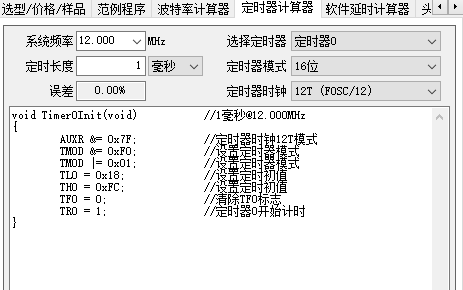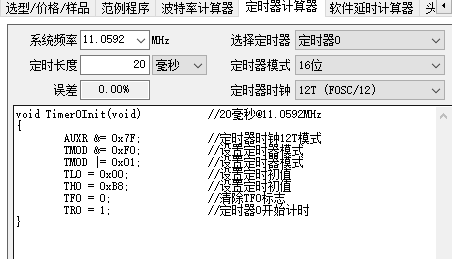The following is calculated by software: 12M crystal oscillator, timer mode 16 bit, 12T, 1 millisecond time

void Timer0Init(void) //1 millisecond@12.000MHz{
AUXR &= 0x7F; //Timer clock 12T mode
TMOD &= 0xF0; //Set timer mode
TMOD |= 0x01; //Set timer mode
TL0 = 0x18; //Set the initial timing value
TH0 = 0xFC; //Set the initial timing value
TF0 = 0; // Clear TF0 flag
TR0 = 1; //Timer 0 starts timing}1.2.3.4.5.6.7.8.9.10.Verify the software's results:
The crystal oscillator is 12M, and one oscillation takes (1/12M) seconds.
A machine cycle of a 12T microcontroller is 12 clock cycles (0.000001 seconds).
The time consumed by a 12M crystal oscillator 12T to work in one machine cycle is (1/12M)*12 seconds = 0.000001 seconds = 1 microsecond
The delay requirement is 1 millisecond, which is 1000 microseconds.
The lower 8 bits and the upper 8 bits are 16 bits in total, 65535, which can only hold 65535 microseconds of time.
THX=(65536-1000)/256=252=0xFC
TLX=(65536-1000)%256 =18=0x18
【Manual calculation】 Use 11.0592M to delay 20 milliseconds
20 milliseconds = 0.02 seconds
One machine cycle takes (12/(11.0592*10^6)) seconds
The cycle used for 0.02 seconds = 0.02/(12/(11.0592*10^6)) = 18432 machine cycles
11.0592M 12T 1 bit 20 milliseconds
TH0=(65536-18432)/256=0xB8
TH0=(65536-18432)%256=0x00
The software verifies my calculations:

void Timer0Init(void) //20 milliseconds @ 11.0592MHz {
AUXR &= 0x7F; //Timer clock 12T mode
TMOD &= 0xF0; //Set timer mode
TMOD |= 0x01; //Set timer mode
TL0 = 0x00; //Set the initial timing value
TH0 = 0xB8; //Set the initial value of timing
TF0 = 0; // Clear TF0 flag
TR0 = 1; //Timer 0 starts timing}1.2.3.4.5.6.7.8.9.10.EA---Global enable bit.
EA=1, turn on the global interrupt control. Under this condition, each interrupt control bit determines whether the corresponding interrupt is turned on or off.
EA=0, turn off all interrupts.
ET2---Timer/Counter 2 interrupt enable bit.
ET2=1, turn on T2 interrupt.
ET2=0, turn off T2 interrupt.
ES---Serial port interrupt enable bit.
ES=1, turn on serial port interrupt.
ES=0, turn off serial port interrupt.
ET1---Timer/Counter 1 interrupt enable bit.
ET1=1, turn on T1 interrupt.
ET1=0, turn off T1 interrupt.
EX1---External interrupt 1 interrupt enable bit.
EX1=1, turn on external interrupt 1 interrupt.
EX1=0, turn off external interrupt 1.
ET0---Timer/Counter 0 interrupt enable bit.
ET0=1, turn on T0 interrupt.
ET0=0, turn off T0 interrupt.
EX0---External interrupt 0 interrupt enable bit.
EX0=1, turn on external interrupt 0 interrupt.
EX0=0, turn off external interrupt 0.
Previous article:C51 WARNING L6: XDATA SPACE MEMORY OVERLAP
Next article:51 single chip microcomputer menu implementation problem
- Popular Resources
- Popular amplifiers
 Professor at Beihang University, dedicated to promoting microcontrollers and embedded systems for over 20 years.
Professor at Beihang University, dedicated to promoting microcontrollers and embedded systems for over 20 years.
- LED chemical incompatibility test to see which chemicals LEDs can be used with
- Application of ARM9 hardware coprocessor on WinCE embedded motherboard
- What are the key points for selecting rotor flowmeter?
- LM317 high power charger circuit
- A brief analysis of Embest's application and development of embedded medical devices
- Single-phase RC protection circuit
- stm32 PVD programmable voltage monitor
- Introduction and measurement of edge trigger and level trigger of 51 single chip microcomputer
- Improved design of Linux system software shell protection technology
- What to do if the ABB robot protection device stops
- Allegro MicroSystems Introduces Advanced Magnetic and Inductive Position Sensing Solutions at Electronica 2024
- Car key in the left hand, liveness detection radar in the right hand, UWB is imperative for cars!
- After a decade of rapid development, domestic CIS has entered the market
- Aegis Dagger Battery + Thor EM-i Super Hybrid, Geely New Energy has thrown out two "king bombs"
- A brief discussion on functional safety - fault, error, and failure
- In the smart car 2.0 cycle, these core industry chains are facing major opportunities!
- The United States and Japan are developing new batteries. CATL faces challenges? How should China's new energy battery industry respond?
- Murata launches high-precision 6-axis inertial sensor for automobiles
- Ford patents pre-charge alarm to help save costs and respond to emergencies
- New real-time microcontroller system from Texas Instruments enables smarter processing in automotive and industrial applications
- Pengpaiwei PT32L033 series overview and features
- Introduction to TI's fifth-generation DSP product TMS320C5X
- 51 Microcontroller timer 0 affects the normal operation of timer 1. How to solve it?
- Drone battery power monitoring system based on Gizwits IoT platform
- Linear power supply chips are hot? Problem analysis
- 【RT-Thread Reading Notes】5. RT-Thread Study Chapter 6 Reading Notes (Part 2)
- Please advise on the spike problem on the 5V power supply
- MSP430 and ATK-NEO-6M GPS module
- 802.11af White-Fi Technology
- [Nucleo G071 Review] Detecting HTS221 Temperature and Humidity Sensor Data

 OPA336N/250
OPA336N/250
















 京公网安备 11010802033920号
京公网安备 11010802033920号